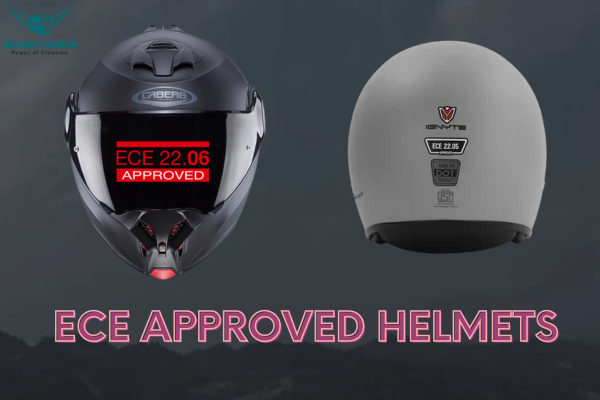The ECE-approved helmets stand out among the reputable helmets, especially in European countries. Only a certified helmet offers reliable protection.
It’s critical to know the reputable helmet certifying bodies and their testing procedures. Only then can you make an informed choice on the trustworthy certifying organization?
ECE is renowned all over the European countries and beyond. However, not every rider understands its standard testing procedures and genuine certification mark. The post explains all you need to know about ECE certification
What Are ECE Approved Helmets?
ECE in full means economic commission for Europe. The ECE helmet certification operates in over 50 countries. It sets the minimum helmet safety standard that each manufacturer must attain for its helmet to be used on public European roads.
So, the ECE-approved helmets have the ECE certification mark. It means they have attained or surpassed the standard set penetration, retention, and impact attenuation tests.
For you to ride on European roads, you must wear a helmet that conforms to the motorcycle safety standards as set by ECE. That way the consumers enjoy the protection and comfort of quality helmets.
What is the ECE 22.06 Standard?
One of the most critical safety equipment for riders is a helmet. The ECE has over the years set particular standards that each helmet must achieve. In the past, the organization relied on ECE 22.02 as the benchmark.
Then it was upgraded to the ECE. 22.05 as the minimum helmet certification allowed on public roads. However, from the year 2020, the Economic Commission for Europe unveiled another standard, ECE 22.06 certification that requires even tougher demands in tests and quality.
Unlike in the previous ECE 22.05 standard, the new ECE 22.06 subjects a helmet to even more stringent tests. For instance, the latest standard test evaluates rotational impact.
Meaning the best ECE 22.06 helmets have the ability to handle rotational forces in case of an accident. So, the best ECE 22.06 helmets have the advantage of preventing injuries due to the rotational forces.
Key Features of ECE 22.06 Helmets
The additional testing procedures and standards for the ECE 22.06 helmets result in enhanced protection. The ECE 22.05 impact testing employed a specific speed and dropped the helmet to a flat anvil surface.
The new ECE 22.06 demands that the new impact tests be carried out at various speeds (lower and higher speeds, angles and measure the effect on the diverse parts of the helmet. A helmet that has passed impact testing at diverse speeds and broad angles has enhanced helmet safety features.
Comparing ECE with Other Safety Standards
DOT
After a manufacturer has produced its helmets, he then subjects them to the preset DOT standards. That is the impact, retention, penetration, and peripheral vision tests. And if it meets the threshold then it attaches the DOT certification mark to them.
However, the NHTSA then picks a few helmets at random to verify if they truly meet the DOT safety standards. In case it fails the test the company incurs a heavy fine which may amount to even $5000 per helmet.
ECE
All the helmets in European countries must satisfy the ECE safety requirements. Similar to DOT tests, ECE also covers impact and penetration. Further, it defines the particular user details and information a manufacturer must include.
In the ECE vs DOT helmet comparison, ECE has well-defined test procedures and requirements for various types such as motorcycle and bicycle helmets.
SNELL
Unlike DOT and ECE, SNELL isn’t a mandatory helmet certification in any country or enforced by any government. However, the certification has more stringent tests and labeling requirements.
Thus, it’s a worldwide respected helmet certification organization. The testing covers impact, roll-off, dynamic retention tests, chin bar impact, and penetration tests for the shield and shell.
Choosing the ECE-approved helmets bestows the following potential benefits:
Assured Peripheral Visibility
Visibility in helmets affects the safety level of the equipment. ECE tests helmets and only certifies those with proper peripheral visibility. So, you won’t strain while riding on the road.
Better Impact Protection
No helmet provides one hundred percent guaranteed safety against crashes. But helmets certified by ECE have passed demanding tests and thus provide a higher margin of safety. Therefore, it’s more likely to prevent you from sustaining crashes leading to death.
Cushion Against Rotational Forces Related Injuries
Not every helmet has features that protect you against rotations. A helmet that meets or surpasses ECE standards has sufficient protection against brain injuries arising from rotational forces.
Reliable Chin Strap and Locks
ECE helmets assure you of a chin strap and lock that remains intact even after an impact. For that, you get a helmet that’s less likely to come off unexpectedly.
When choosing helmets safety, quality and comfort should form the base selection criteria. Go for the helmets that have proven impact, penetration, and retention protection. ECE-approved helmets are thus reliable on that ground.
The far-reaching ECE 22.06 tests on helmet impact protection from varied angles, different speeds, peripheral vision, and chin retention ability make them reliable choices.


Related Posts
Top 10 Best Modular Helmet: The Practical Balance Between Breathability and Safety Problems
The best modular helmet provides the benefits of both worlds. It’s a versatile helmet that adapts to various settings. While [...]
Best Scorpion Modular Helmets For Safe Adventure Rides
Scorpion has been in the helmet industry for over a century. Therefore, you can count on the safety and comfort [...]
Best Flip-up Helmet : TOP Recommendations From Experts
The best flip-up helmet adds versatility and convenience and hence makes every tour ride enjoyable. However, it doesn’t have to [...]
What Is a Modular Helmet? Everyone Wants to Know!
As a motorcycle rider, you should know what is a modular helmet since it may just be what you need. [...]